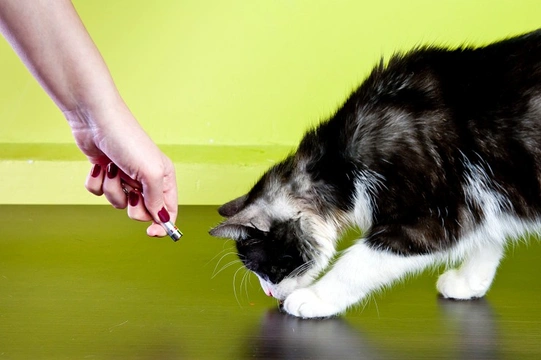
Are laser pointers good toys for cats?
Many cats become rather sedentary as they get older, preferring to eat and sleep rather than playing, hunting and exploring the world. This is a natural part of aging, but can also lead to weight gain over time, which can have a direct and negative impact on your cat’s overall health and longevity. This means that many cat owners look for toys and games to use to encourage their cat to play and get moving, and today, laser pointer toys are one of the most common and popular interactive cat toys on the market.
Cats of all ages from playful kittens to senior cats will often engage with laser pointer play, which can help to provide stimulation and encourage your cat to get mobile, with minimal effort on the part of you as the owner!
This is of course a good thing – but are laser pointer toys as a whole good for cats, or are there better options available? Is using a laser pointer toy with your cat safe? If you are asking these questions or wondering anything else about laser toys and cats, in this article, we will cover the pros and cons of laser pointer toys, and share some safety tips too. Read on to learn more.
Laser cat toys and safety
Any toy that you use to play with your cat should be safe and designed specifically for the purpose – which means that if you want to use a laser pointer toy to play with your cat, you should choose one that is designed for cats, and not for any other purpose.
This particularly means steering clear of high-powered laser pointers and any that are not specifically manufactured and sold with cats in mind.
Laser pointers come in a wide range of different light intensity ranges, and some of these are high enough to cause permanent damage to the eyes in some cases. Laser pointer toys that are considered to be safe for playing with cats (and dogs and children too) should have a power rating of five milliwatts or less – anything higher than this is potentially dangerous.
Additionally, you should never point the laser directly at your cat’s face or eyes, instead projecting it at an inanimate object within your cat’s field of vision.
Keep play interactive
Engaging your cat to play with you can help to strengthen your bond and of course, keep your cat fit – but this play should be interactive not one-sided, and you should pay attention to your cat’s mood, responses, and feedback to the game. Automated laser toys that can be deployed remotely or that move independently might seem like a zero-effort way to entertain your cat, but this can be confusing for your cat, if a laser suddenly starts moving around for no reason when your cat is at rest and of course, cannot be caught by your cat.
In some cats, this can lead to anxiety and stress-related behaviours, so make sure that you supervise play and keep an eye on your cat’s reactions, stopping if they become irritated or overstimulated.
Knowing when to stop
When a cat has had enough of a game, they will tend to stalk off and simply stop playing and ignoring it – and cats often call a natural end to play by stalking off with their “prey” or the toy they were playing with to enjoy the spoils of their labour in peace.
However, because a laser pointer is a toy that your cat cannot catch, there is no natural “end” to the game unless your cat simply walks away when they have had enough, which due to the cat’s strong prey drive, may be past the point at which they were having fun.
As the cat owner, it is important for you to keep play sessions short, fun and engaging, and not continue when your cat has had enough or seems to be losing interest. Offer a treat or reward at the end of a play session to provide positive feedback at the end of the game.
Avoiding frustration
Chasing a laser pointer mimics hunting behaviour in cats, and the small, erratically moving light of the pointer often triggers the cat’s strong prey drive. However, as mentioned, the laser pointer cannot be “caught” like real prey, or even other types of interactive toys, such as a ribbon, feather or small ball or other chasing toy.
This inability on the part of the cat to “win” the game may mean that playing with the laser pointer is their favourite game because there is a continual challenge, but with no reward in play and the laser being impossible to catch, it can lead to frustration in your cat too.
If your cat seems to find the game annoying rather than fun or if they get frustrated by the lack of reward at the end of it, using a different type of toy like a feather on a stick or something else that your cat can physically grab hold of and catch may be a better choice.



